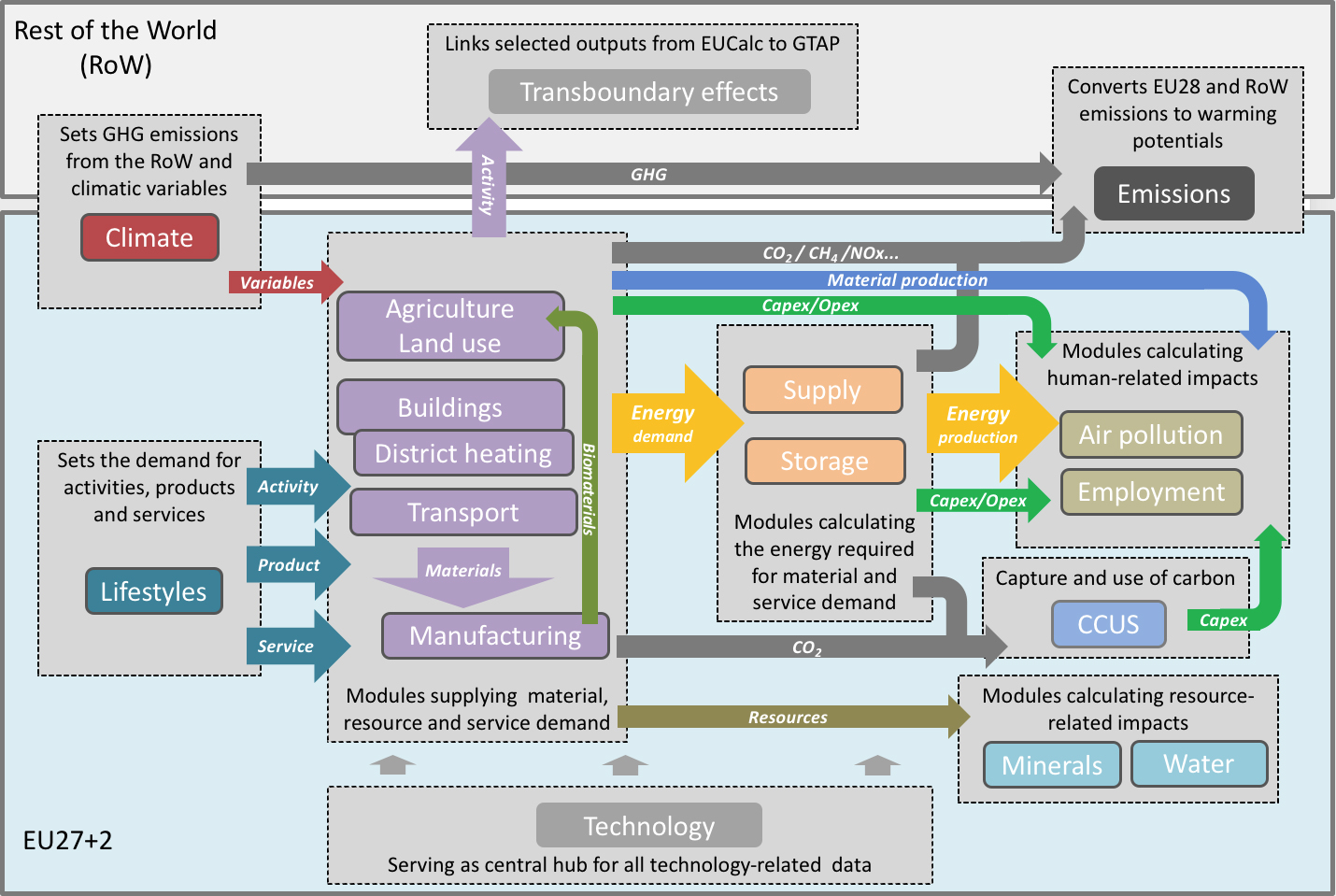The EUCalc model
Overview
The EUCalc models energy, resources, production and food systems at the EU level + UK and Switzerland (EU27+2) under pre-defined (but adjustable) levels of ambitions in regard to technological deployment and consumption behaviour. The modelling approach was inspired by the family of so called 2050 Calculators which were spearheaded by the call for more transparent approaches to address the challenge of reducing carbon emissions.

Main flows of energy, materials and emissions and sectoral connections in the EUCalc model. Source: Costa et al 2020 (submitted)
The model
The EUCalc is composed of 15 inter-dependent modules representing the supply and demand sides of activities, materials, energy and emissions; as well as different interfaces of the energy system with society and the environment. At its core, are modules representing the energy-relevant sectors of agriculture, buildings, power/storage, transport and manufacturing. These modules respond to the demand for products, activities and services originated in the lifestyle module and, where relevant (e.g. agriculture and buildings), are impacted by changes in climate modelled by the climate module.
The energy system interacts with the environment via modules simulating the supply and demand for water and minerals. The implications of air pollution and employment are also accounted for. Emissions captured in manufacturing processes or energy production is treated in the CCUS module. Finally, impacts on the trade of products, materials and food, as well as the carbon embodied in trade outside EU27+2 are modelled with a modified version of the GTAP (Global Trade Analysis Project) model in the Transboundary effects module.
An overview of all modules can be found here.
The development of the EUCalc model benefited from an intensive consultation process regarding key assumptions and modeling scope. This was done with sectoral experts across nine co-creation workshops and a public Call for Evidence.
Using the model
The model can be easily used via its web-interface called the Transition Pathways Explorer allowing users to swiftly simulate scenarios and visualize model outputs, illuminate inter-sectoral synergies, and explore abroad range of decarbonisation options. Alternatively, the model can be downloaded from its online repository. Before being able to run the project on your local machine you need to install the KNIME Anatytics Platform 3.7.2 and Python 3.6.
Please be aware that this work is licensed under a Creative Commons Attribution-NonCommercial-ShareAlike 4.0 International License.
In case of using or improving it consider the copyright © EUCalc Project 2020, released under CC-BY-NC-SA-4.0.
![]()
Publications
Luís Costa, Vincent Moreau, Boris Thurm, Wusheng Yu, Francesco Clora, Gino Baudry, Hannes Warmuth, Bernd Hezel, Tobias Seydewitz, Ana Ranković, Garret Kelly and Jürgen P. Kropp. The decarbonisation of Europe powered by lifestyle changes, Environmental Research Letters, 2021, 16, 044057.
BPIE, A. V. Roscini, O. Rapf, and J. Kockat, Contributions from the building sector to a strengthened 2030 climate target – On the way to a CLIMATE-NEUTRAL EUROPE 2030, Brussels, 2020.
Gyalai-Korpos M, Zentkó L, Hegyfalvi C, Detzky G, Tildy P, Hegedűsné Baranyai N, Pintér G and Zsiborács H, The Role of Electricity Balancing and Storage: Developing Input Parameters for the European Calculator for Concept Modeling, Sustainability 12 811, 2020.
Costa, L., & Moreau, V. (2019). The emission benefits of European integration. Environmental Research Letters, 14, 084044.
Füllemann, Y., Moreau, V., Vielle, M., & Vuille, F. (2020). Hire fast, fire slow: the employment benefits of energy transitions. Economic Systems Research, 32(2), 202-220.
Francesco Clora, Wusheng Yu, Gino Baudry and Luis Costa. (2021) Impacts of supply-side climate change mitigation practices and trade policy regimes under dietary transition: the case of European agriculture. Environ. Res. Lett. 16 124048.
Clora, F., & Yu, W. (2022). GHG emissions, trade balance, and carbon leakage: Insights from modeling thirty-one European decarbonization pathways towards 2050. Energy Economics, 106240.
Gino Baudry, Luis Costa, Alexandre Strapasson, Lorenzo Di Lucia, Raphael Slade, Morgan Raffray, Jeremy Woods, Onesmus Mwabonje, Jerome Meessen. (2021). Exploring the future of the European food and agriculture system: the nexus of lifestyles and production system, Environmental Research Letters (under review).
Xiang Li, Boris Thurm, Gino Baudry, Luis Costa, Rachel Warren, Jeff Price, Hannes Warmuth, Marc Stettler, Garret Patrick Kelly, Ana Ranković, Onesmus Mwabonje, Alexandre Bouchet, Morgan Raffray, Bernd Hezel, Stuart Jenkins, Francesco Clora, Wusheng Yu, Alexandra Collins, Patricia Osseweijer, John Posada Duque, Juergen P. Kropp, Manuele Margnil, François Maréchal, On the sustainability of a negative-emission Europe, Science, 2022 (submitted).
Baudry, G., Costa, L., Di Lucia, L. et al. An interactive model to assess pathways for agriculture and food sector contributions to country-level net-zero targets. Commun Earth Environ 4, 46 (2023).
